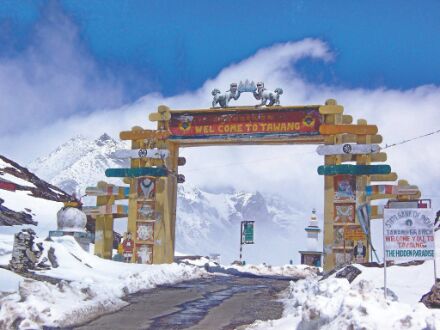Carnage at Chayang Tajo
Decades on, details regarding the brutal killings at Chayang Tajo remain uncertain

In the early 1960s, Arunachal Pradesh was known as the North-East Frontier Agency (NEFA). Although NEFA was very peaceful, there were a couple of violent incidents which shook the local administration. One such ghastly incident took place in Chayang Tajo in May 1963.
Such was the infamy of Chayangtajo, that Government officials dreaded posting to this remote circle headquarter in East Kameng District (then under the undivided Kameng Division) which was in those days accessible only by foot.
What happened at Chayangtajo? On May 31, 1963, everything appeared peacefully relaxed in Chayang Tajo. The CRP personnel who were deputed to guard the government offices were participating in sports activities. A group of local tribal people had assembled and were busy in attending to some miscellaneous odd jobs like the repair of fencing.
Suddenly, one person shouted "Khe Khe" and on hearing this signal, the locals pounced upon the CRP men and the Government personnel and caught them unawares. Nine persons including Shri PG Roy, the Base Superintendent, his staff and five CRP personnel were killed. Later, the killers went to the nearby Pawik River area where they apprehended three more CRP sepoys who were coming to Chayangtajo from Khenewa and also killed them. One sepoy namely, Shri Ajit Singh, was the only survivor of this carnage and he managed to escape and report the incident early next morning to the Base Superintendent at Khenewa. Two days later, the killers assembled at Tajo Village and performed their traditional "Ropke Tame" puja to celebrate the success of their operation.
News of the killings was received with shock, disbelief and anger at Seppa, the then sub-divisional headquarters. A team of Government officials under the Political Officer, Shri T Haralu and escorted by Assam Rifles personnel immediately left for Chayang Tajo. However, since the killers had demolished a bridge on the Kameng River, the team could reach Chayang Tajo only on June 18, 1963, through an alternative and difficult route. The team apprehended twenty persons suspected of the killings without encountering any resistance. Nine bodies of the victims were recovered. However, three bodies of the CRP sepoys killed in the Pawik River area could not be recovered as they had been thrown in the mountain river and had been carried by the current.
Of the twenty persons who were apprehended, two were killed when they attempted to escape from the Assam Rifles custody. The remaining eighteen persons were committed for trial and charged under sections 302 /304 etc., of the IPC.
Two accused persons became approvers. The remaining sixteen accused persons pleaded guilty to the charges framed against them. However, since the accused persons were illiterate and ignorant, the court decided that the trial would proceed according to law.
After the conclusion of the trial, on April 28, 1964, the Additional Political Officer & Sessions Judge, Kameng Frontier Division (In NEFA, Judiciary was not separated from the Executive), convicted eleven accused persons for murder and sentenced three of them to death and the remaining persons to rigorous imprisonment for life. Four accused persons were convicted under section 326 of IPC and sentenced to imprisonment for terms ranging from three to seven years. One accused person was acquitted of all charges. The death sentence passed on the three accused was however later commuted to life imprisonment
Twenty-six years after this ghastly incident, I was posted to East-Kameng District. During my visits to Chayangtajo, I found that there was something about the place that refused to die. The memories of the tragic incidents were apparently still alive.
Why did this senseless massacre occur? My posting in the district enabled me to access official records including records of the trial. More importantly, it gave me the opportunity to meet some of the convicts who, after serving their sentence in Tezpur Jail, had already been released
At the trial, the prosecution established beyond doubt that the killings were premeditated. However, what was the motive for the killings?
During the 1962 war with China, the administrative outpost at Chayangtajo was closed down and the Assam Rifles personnel were withdrawn from there. While withdrawing, the Assam Rifles personnel had left behind some of their arms and ammunition which subsequently came into the possession of the local tribal people. When the administrative outpost of Chayangtajo was reestablished in 1963, the local people were directed to return the weapons. However, they returned only a few bad and unserviceable weapons. When finally an ultimatum was issued to them for returning all the weapons, maybe the local tribal people were provoked. Maybe, they expected the Government to take punitive action against them and therefore decided to take preemptive action.
Were the killings due to resentment against the local administration? As per the trial records, none of the accused had mentioned any grievance against the administration. But there are other versions too which seem to indicate otherwise.
The Bangni people, who inhabit Chayang Tajo, are simple and straightforward as is evident from the fact that all the accused persons pleaded guilty during their trial. Bangnis are fiercely independent and are known to be tough, strong and aggressive. Even, the British had failed to subdue them completely and they were largely left to themselves during British rule. It is possible that they resented being brought under a settled administration and saw their chance in the immediate aftermath of the war with China in 1962.
We will perhaps never know the truth. While it is perhaps now time to move on, maybe there are also some lessons that need to be learnt.
The writer was the Deputy Commissioner, East Kameng District, Arunachal Pradesh during 1989-90. Views expressed are personal



